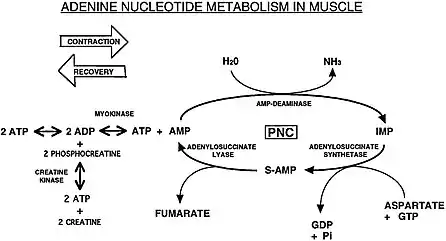Phosphagen
Phosphagens, also known as macroergic compounds, are high energy storage compounds, also known as high-energy phosphate compounds, chiefly found in muscular tissue in animals. They allow a high-energy phosphate pool to be maintained in a concentration range, which, if it all were adenosine triphosphate (ATP), would create problems due to the ATP-consuming reactions in these tissues. As muscle tissues can have sudden demands for much energy, these compounds can maintain a reserve of high-energy phosphates that can be used as needed, to provide the energy that could not be immediately supplied by glycolysis or oxidative phosphorylation. Phosphagens supply immediate but limited energy.
The actual biomolecule used as a phosphagen is dependent on the organism. The majority of animals use arginine as phosphagen; however, the phylum Chordata (i.e., animals with spinal cords) use creatine. Creatine phosphate (CP), or phosphocreatine (PCr), is made from ATP by the enzyme creatine kinase in a reversible reaction:
- Creatine + ATP ⇌ creatine phosphate + ADP + H+ (this reaction is Mg2+-dependent)
However, annelids (segmented worms) use a set of unique phosphagens; for example, earthworms use the compound lombricine.
Phosphagens were discovered by Philip Eggleton and his wife Grace Eggleton.[1]
Reactions
The Phosphagen System (ATP-PCr) occurs in the cytosol (a gel-like substance) of the sarcoplasm of skeletal muscle, and in the myocyte's cytosolic compartment of the cytoplasm of cardiac and smooth muscle.[2]

During muscle contraction:
- H2O + ATP → H+ + ADP + Pi (Mg2+ assisted, utilization of ATP for Muscle contraction by ATPase)
- H+ + ADP + CP → ATP + Creatine (Mg2+ assisted, catalyzed by creatine kinase, ATP is used again in the above reaction for continued muscle contraction)
- 2 ADP → ATP + AMP (catalyzed by adenylate kinase/myokinase when CP is depleted, ATP is again used for muscle contraction)
 Phosphagen System (ATP-PCr) and Purine Nucleotide Cycle (PNC)
Phosphagen System (ATP-PCr) and Purine Nucleotide Cycle (PNC)
Muscle at rest:
- ATP + Creatine → ADP + CP + H+ (Mg2+ assisted, catalyzed by creatine kinase)
- ADP + Pi → ATP (during anaerobic glycolysis and oxidative phosphorylation)
When the Phosphagen System has been depleted of phosphocreatine (creatine phosphate), the resulting AMP produced from the adenylate kinase (myokinase) reaction is primarily regulated by the Purine Nucleotide Cycle.[3][4]
References
- Selected Topics in the History of Biochemistry, G Semenza
- Wallimann T, Wyss M, Brdiczka D, Nicolay K, Eppenberger HM. Intracellular compartmentation, structure and function of creatine kinase isoenzymes in tissues with high and fluctuating energy demands: the 'phosphocreatine circuit' for cellular energy homeostasis. Biochem J. 1992 Jan 1;281 ( Pt 1)(Pt 1):21-40. doi: 10.1042/bj2810021. PMID: 1731757; PMCID: PMC1130636.
- Bhagavan, N.V.; Ha, Chung-Eun (2015), "Contractile Systems", Essentials of Medical Biochemistry, Elsevier, pp. 339–361, retrieved 2022-12-21
- Valberg, Stephanie J. (2008-01-01), Kaneko, J. Jerry; Harvey, John W.; Bruss, Michael L. (eds.), "Chapter 15 - Skeletal Muscle Function", Clinical Biochemistry of Domestic Animals (Sixth Edition), San Diego: Academic Press, pp. 459–484, ISBN 978-0-12-370491-7, retrieved 2023-10-10
Further reading
- Ellington, W Ross (2001). "Evolution and Physiological Roles of Phosphagen Systems". Annual Review of Physiology. 63 (1): 289–325. doi:10.1146/annurev.physiol.63.1.289. ISSN 0066-4278. PMID 11181958.
- Eggleton, Philip; Eggleton, Grace Palmer (1927). "The physiological significance of "phosphagen"". Journal of Physiology. 63 (2): 155–161. doi:10.1113/jphysiol.1927.sp002391. PMC 1514923. PMID 16993876.
- Eggleton, Philip; Eggleton, Grace Palmer (1928). "Further observations on phosphagen". Journal of Physiology. 65 (1): 15–24. doi:10.1113/jphysiol.1928.sp002457. PMC 1515019. PMID 16993934.
- Baldwin, Ernest (1933). "PHOSPHAGEN". Biological Reviews. 8 (1): 74–105. doi:10.1111/j.1469-185X.1933.tb01088.x. ISSN 1464-7931. S2CID 221532329.